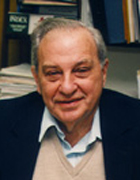
Prof. Rudolph A. Marcus (*1923)
Professur
Arthur Amos Noyes Professor of Chemistry, California Institute of Technology, USA (since 1978)
Nobel Prize in Chemistry 1992
TUM Distinguished Affiliated Professor (2009) of the department Chemistry
Research Areas
Rudolph A. Marcus received the Nobel Prize for Chemistry in 1992 for his work on the theory of electron transfer in chemical systems. The basic principles of the theory date back to the 1960s, but were not proved in experiments until the 1980s. The Nobel Prize winner’s close collaboration with biophysics/theoretical chemistry researchers at TUM began in the 1970s when he worked there thanks to an Alexander von Humboldt Foundation Scientist Award. He contributed to the success of the German Research Foundation’s collaborative research centers working on photosynthesis projects coordinated by TUM (Prof. Michel-Beyerle). Three scientists were awarded the Nobel Prize for this work in 1988 (Johann Deisenhofer, Robert Huber and Hartmut Michel).
Academic Career
Rudolph A. Marcus received his B.Sc. (1943) and Ph.D. (1946) in chemistry at McGill University, Montreal. After that, he worked as a postdoctoral researcher at the National Research Council of Canada (1946-49) and the University of North Carolina (1949-51). He worked at the Polytechnic Institute of Brooklyn from 1951 to 1964 and the University of Illinois from 1964 to 1978. After that, he accepted the position of Arthur Amos Noyes Professor of Chemistry at California Institute of Technology. In addition to the Nobel Prize, Prof. Marcus has received numerous honorary titles and accolades, including the National Medal of Science (1989), the Irving Langmuir Prize and the Peter Debye Prize of the American Chemical Society (1978, 1988). He has also been awarded the Robinson and Centenary Medals of the Faraday Division of the Royal Society of Chemistry (1982, 1988).
If you wish your profile to be changed or updated please contact Franz Langer.